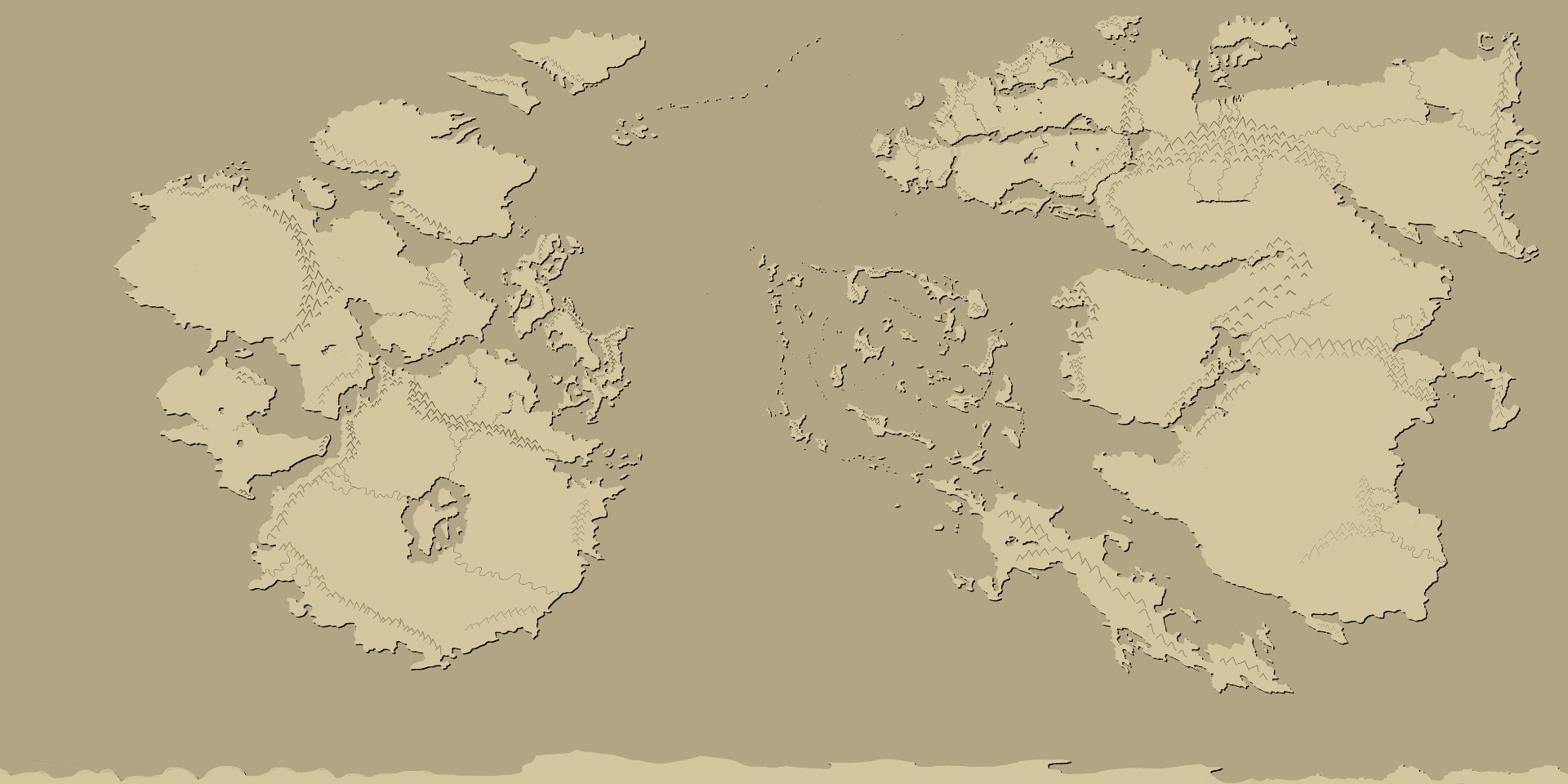
The Hauberian Empire
Der Hauberishe Kaiserreich (The Hauberian Empire)
Government: Liberal autocracy with aristocratic representation
Head of State: Emperor Wilhelm VI of house Dursell
Capital: Kaisersberg
Ruling race: Human
The empire is a gathering of duchies and vassal states ruled by an aristocratically elected emperor. Compared to the commonwealth, the empire is nearly twice in size but is still trailing behind with trade and industry because of how tradition is seen as superior to innovation, making the transition from the old ways to more efficient means a slow and arduous process. But tradition has their perks, as it's known that the Hauberian empire's crafting is masterly and their military is strong. The empire has the largest and best equipped standing army of all empires, but their fleet is severely lacking. Because of this a great effort has been put in over the last couple of years to strengthen and expand both the military and trade fleet, but as with all things, tradition makes it a slow process.
Beside tradition, another feature of the Hauberian empire is thought. Many prominent philosophers through history have come from the regions within the empire. Their works count as the foremost within fields of ontology and epistemology, as well as political and social thinking having a huge impact on modern society. This has also had a major influence on aesthetics, saying that both mind and soul needs to be pleased, making art, drama and music pillars of the Hauberian society. Another pillar that holds society is hierarchy and the belief of everything in its right place. Things such as a family's reputation, trade, and heritage are highly defining factors of the individual and one's life choices. It is believed that through hierarchy comes order and from that comes harmony. The backside is however that society is highly divided into social classes and a near non-excitant upward mobility. Peasants remain as peasants and nobles remain as nobles.
Any valid historical study of the Hauberian Empire must begin of the period known as the Wars of the Hundred Kingdoms. The name itself is a bit of a misnomer, as this two and a half century period included the rise and fall of roughly one hundred and thirty two different kingdoms, and there were several periods of relative peace, but as these kingdoms sought to best each other through diplomacy and warfare numerous cultural elements came to be. It was in this period that mounted knights were seen charging into ranks of spearman hurling their own short spears into the ranks. Nobles were expected to fight from horseback, with loyal retainers known as kapitans, or captains, which would lead ranks of spearmen in grand formations.
This era brought in major social change. It saw serfdom dissolved as nobles, desperate for fighting men, would grant citizenship in exchange for military service to the families of those that served. It was is also during this time that a uniformed language evolved as the countless local languages of the period meshed with each other as political lines were drawn and redrawn until only a handful of regional dialects remained. Three inventions of this time have also been heralded as pivotal to bring in change to society, namely the crossbow, the printing press and the improved shield.
The printing press, allowed, codified law, written orders, and more importantly books to be quickly distributed. A new scholarly class emerged, comprising tacticians, scientists, engineers, theologians, lawyers, poets and writers. Now even common men owned books, political discourse was common in inns and great artisans would sell manuals to mastering the craft. Standardization would soon be adopted for units of measure and for currency, and as the wars wound down just a score of kingdoms remained standing.
Sadly the wars between kingdoms had gotten out of hand, one of the warring kingdoms known as Fuerheim, became the personification of a new concept, the war crime. Fuerhiem had run afoul of another, larger kingdom known as Schweinfeld. The war quickly went poorly for Fuerhiem which still using older tactics quickly fell to the superior numbers and weapons of Schweinfeld. Thrown spears were no match for crossbows hidden behind emplaced shields. And while the knights of Fuerheim fought well, adopting reading tactics using mounted shields and swords the losses on the battlefield were telling. Lord Fuerheim faved a flag of truce and offered his surrender in exchange for his people's safety. Lord Schweinfeld refused, deciding instead to make an example of Fuerheim and his people. While still under a flag of truce Lord Fuerhiem was executed. Then his people and cities were put to the torch. Lord Schweinfeld felt that since he had the largest known army equipped with the most modern weapons this would cause his rivals to cower and bow before him. This was not the case.
The merchant kingdom led by King Hauber, heard of the fate of their trading partner, Fuerheim, and sent letters depicting the massacres to all the surrounding kingdoms. The twenty strongest kingdoms, armed with iron and being outraged, declared war on Schweinfeld. The war was swift, brutal, and decisive. Unlike the armies of Schweinfeld, the armies of the Hauberian League as it was called would spare any cities that surrendered and absorb them into the league, at the end Lord Schweinfeld was captured and by the council of twenty kings who had banded together was judged and publicly executed.
The kings then made history, led by Hauber, they formed a council, which would meet in Huaber's capital city, Kaisersberg. As its first official act the council codified the rules of warfare and would pass general law for the region. A unified currency was adopted and the Hauberian Council of twenty became a forum for discussing business between kingdoms. This peace would last close to a century, with only minor skirmishes that never erupted into full blown war.
Technology continued to advance, mounted knights wore heavy plates of steel, massive siege crossbows hurled massive bolts and a new trend would develop. The Hauberian peoples would fall in love with a technology and take it to an extreme, developing it for every conceivable use, crossbows became massive, for siege, light for mounted hunting and later mounted combat, or high powered for better range for the infantryman. The knife became a miniature sword, a tool, could be pole mounted to make a pike. Kapitans would adopt larger swords for defeating pikes. Infantry would carry sword-like fighting knives, and nobles would adopt various styles of sword for mounted and foot combat as well as dueling.
Wars would erupt again, but this time alliances became the newest weapon of war. Five great kings would rally smaller kingdoms to their banner, wars erupted over the true worship of the Light Bearer, economics, or even land disputes. The council of twenty tried to prevent these wars but in the end two hundred years of warfare would commence. Knights with handheld crossbows would unleash an opening salvo before cloning with swords. Knife tipped pikes would stab and slash, and bolts would darken the sky. Once again it was Hauberia that would end the war, ironically through politics and the working class. Warfare was bad for the economy, food shortages became common and Huaberia, having stayed neutral, would sell food and other goods to all 5 factions.
The king Friedrich Drusell, shrewdly, hired mercenaries from all the cities he traded with to safeguard the shipments. Soon his mercenary forces outnumbered the standing armies in each kingdom. During the same time pamphlets outlining the benefits of unifying were found in every village and town. A few short years later riots would erupt in all the warring kingdoms, and the mercenaries loyal to Friedrich joined with the rioters, soon all five kings would surrender. Interestingly very few lost their lives during the coup, mostly just a few stubborn guards when the riots got out of hand.
Under Friedrich the five kings would serve as the highest court in the land, called The Court of Five, and the council of 20 would serve as a parliament of sorts. All the noble houses managed to save face, and the common people prospered greatly. Companies become the real power of the new empire. And professional soldiers, bearing a shield on their left shoulder with the heraldry of their region (one of the twenty) would become the uniform in later eras, preserving the culture of each region and pride in one's home. The matchlock was adopted slowly, used mostly by merchant guards, and the crossbow remained popular, that is until the percussion cap came to be. The revolver changed everything and once again the engineers of the empire fell in love. Rotating chambers were everywhere.
The noble cavaliers, still mounted on horseback, bearing thier heraldry on their left shoulder on a small decorative metal shield, would ride into battle on noble warhorses blazing away with revolvers and slashing with staring cruciform swords. Infantry clad in Hauberian dark blue uniforms bearing metal shield of their home region on their left arms would march into battle bearing rifles with rotating chambers and wear a long fighting knife on their hips. The famous knife pikes remained in use, as did heavier bullet resistant shields that could be placed as small barricades. Cannons replaced the siege bow, but massive crossbows now fired grappling hooks and such for airships.
The air navy caught on slowly and at first consisted as escorts for merchant ships. Piracy became a problem and a new innovation joined the patrol boats and gunboats of the navy, the boarding ship. These airships would attach like parasites to a larger vessel like a merchant freighter. When pirates attacked the ship would detach, launch grappling hooks and unleash the pride of the Haubarian military might, the noble knights and professional soldiers.
Armed with swords and revolvers, these men would board the ship and cripple or capture the vessel. The ship boarding actions would turn a ship battle into a scraped close quarters fight, something the Empire had mastered ages ago. This tactic proved devastating to pirates and captured ships would be repaired and pressed into service. The boarding teams became an elite force and the common soldiers and noble foot knights alike were treated with great respect.
